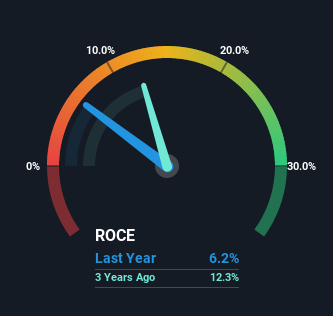Here's What's Concerning About UniFirst's (NYSE:UNF) Returns On Capital
What are the early trends we should look for to identify a stock that could multiply in value over the long term? Amongst other things, we'll want to see two things; firstly, a growing return on capital employed (ROCE) and secondly, an expansion in the company's amount of capital employed. Basically this means that a company has profitable initiatives that it can continue to reinvest in, which is a trait of a compounding machine. However, after briefly looking over the numbers, we don't think UniFirst (NYSE:UNF) has the makings of a multi-bagger going forward, but let's have a look at why that may be.
Return On Capital Employed (ROCE): What Is It?
For those who don't know, ROCE is a measure of a company's yearly pre-tax profit (its return), relative to the capital employed in the business. To calculate this metric for UniFirst, this is the formula:
Return on Capital Employed = Earnings Before Interest and Tax (EBIT) ÷ (Total Assets - Current Liabilities)
0.061 = US$134m ÷ (US$2.4b - US$244m) (Based on the trailing twelve months to August 2022).
Therefore, UniFirst has an ROCE of 6.2%. In absolute terms, that's a low return and it also under-performs the Commercial Services industry average of 9.3%.
View our latest analysis for UniFirst
Above you can see how the current ROCE for UniFirst compares to its prior returns on capital, but there's only so much you can tell from the past. If you're interested, you can view the analysts predictions in our free report on analyst forecasts for the company.
The Trend Of ROCE
On the surface, the trend of ROCE at UniFirst doesn't inspire confidence. Around five years ago the returns on capital were 10%, but since then they've fallen to 6.2%. However it looks like UniFirst might be reinvesting for long term growth because while capital employed has increased, the company's sales haven't changed much in the last 12 months. It may take some time before the company starts to see any change in earnings from these investments.
What We Can Learn From UniFirst's ROCE
To conclude, we've found that UniFirst is reinvesting in the business, but returns have been falling. And investors may be recognizing these trends since the stock has only returned a total of 14% to shareholders over the last five years. Therefore, if you're looking for a multi-bagger, we'd propose looking at other options.
On a final note, we've found 1 warning sign for UniFirst that we think you should be aware of.
While UniFirst may not currently earn the highest returns, we've compiled a list of companies that currently earn more than 25% return on equity. Check out this free list here.
Have feedback on this article? Concerned about the content? Get in touch with us directly. Alternatively, email editorial-team (at) simplywallst.com.
This article by Simply Wall St is general in nature. We provide commentary based on historical data and analyst forecasts only using an unbiased methodology and our articles are not intended to be financial advice. It does not constitute a recommendation to buy or sell any stock, and does not take account of your objectives, or your financial situation. We aim to bring you long-term focused analysis driven by fundamental data. Note that our analysis may not factor in the latest price-sensitive company announcements or qualitative material. Simply Wall St has no position in any stocks mentioned.
Join A Paid User Research Session
You’ll receive a US$30 Amazon Gift card for 1 hour of your time while helping us build better investing tools for the individual investors like yourself. Sign up here

